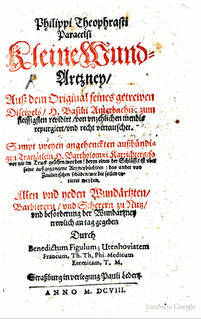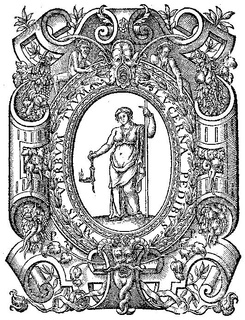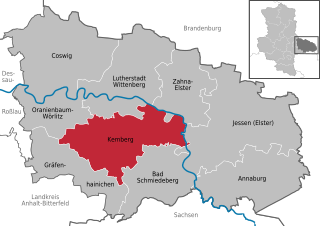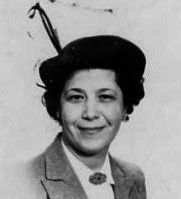
Theodor Zwinger the Elder was a Swiss physician and humanist scholar. He made significant contributions to the emerging genres of reference and travel literature. He was the first distinguished representative of a prominent Basel academic family.

Paracelsus, born Theophrastus von Hohenheim, was a Swiss physician, alchemist, and astrologer of the German Renaissance.

An elemental is a mythic being that is described in occult and alchemical works from around the time of the European Renaissance, and particularly elaborated in the 16th century works of Paracelsus. According to Paracelsus and his subsequent followers, there are four categories of elementals, which are gnomes, undines, sylphs, and salamanders. These correspond to the four Empedoclean elements of antiquity: earth, water, air, and fire, respectively. Terms employed for beings associated with alchemical elements vary by source and gloss.

Andreas Libavius or Andrew Libavius was a German physician and chemist.
Thomas Erastus was a Swiss physician and theologian. He wrote 100 theses in which he argued that the sins committed by Christians should be punished by the State, and that the Church should not withhold Sacraments as a form of punishment. They were published in 1589, after his death, with the title Explicatio gravissimae quaestionis. His name was later applied to Erastianism.

Andreas Rudolph Bodenstein von Karlstadt, better known as Andreas Karlstadt or Andreas Carlstadt or Karolostadt, or simply as Andreas Bodenstein, was a German Protestant theologian, University of Wittenberg chancellor, a contemporary of Martin Luther and a reformer of the early Reformation.

Heinrich Khunrath, or Dr. Henricus Khunrath as he was also called, was a German physician, hermetic philosopher, and alchemist. Frances Yates considered him to be a link between the philosophy of John Dee and Rosicrucianism.

Paracelsianism was an early modern medical movement based on the theories and therapies of Paracelsus. It developed in the second half of the 16th century, during the decades following Paracelsus' death in 1541, and it flourished during the first half of the 17th century, representing one of the most comprehensive alternatives to learned medicine, the traditional system of therapeutics derived from Galenic physiology. Based on the principle of maintaining harmony between the microcosm, Man; and macrocosm, Nature.

Thomas Muffet was an English naturalist and physician. He is best known for his Puritan beliefs, his study of insects in regard to medicine, his support of the Paracelsian system of medicine, and his emphasis on the importance of experience over reputation in the field of medicine.

Pietro Perna was an Italian printer, the leading printer of Late Renaissance Basel, the Erasmian crossroads between Italian Renaissance humanism and the Protestant Reformation. His books promoted the Italian heretical thinkers at the origins of Socinianism and the theory of Tolerance. He was a major publisher of Protestant historians like Flacius Illyricus and David Chytraeus and promoted the ars historica treatises of the period, notably the 18 authores de historia in Artis Historicae Penus (1579).
Peder Sørensen, widely known by his Latinized name, Petrus Severinus (1542–1602), was a Danish physician, and one of the most significant followers of Paracelsus. His works include the major treatise Idea medicinae philosophicae (1571), which asserted the superiority of the ideas of Paracelsus to those of Galen. Severinus was a member of Denmark's intellectual elite. His education was supported by the Danish crown and his eventual appointment as royal physician conferred status and authority to his work and opinions. He was a contemporary and intellectual and personal associate of Tycho Brahe who likewise is associated with the evolution of chemistry during the seventeenth century. Daniel Sennert, a professor at Wittenberg wrote in 1619 that most chemical physicians followed the lead of Severinus and even referred to a “Severinian School” of medical theory, which was based on the philosophy of Paracelsus. Scholars including Jole Shackelford and Hiro Hirai have claimed that Severinus was an important predecessor of both Johann Baptista von Helmont and Pierre Gassendi.
Abraham von Franckenberg was a German mystic, author, poet and hymn-writer.

Max Ernst August Bodenstein was a German physical chemist known for his work in chemical kinetics. He was first to postulate a chain reaction mechanism and that explosions are branched chain reactions, later applied to the atomic bomb.
Bernard Gilles Penot was a French Renaissance alchemist and a friend of Nicolas Barnaud.

Robert Wilhelm Eberhard Bunsen was a German chemist. He investigated emission spectra of heated elements, and discovered caesium and rubidium with the physicist Gustav Kirchhoff. Bunsen developed several gas-analytical methods, was a pioneer in photochemistry, and did early work in the field of organoarsenic chemistry. With his laboratory assistant, Peter Desaga, he developed the Bunsen burner, an improvement on the laboratory burners then in use. The Bunsen–Kirchhoff Award for spectroscopy is named after Bunsen and Kirchhoff.
The year 1528 in science and technology included a number of events, some of which are listed here.
Bodenstein is a German surname. Notable people with the surname include:

Benedictus Figulus of Utenhofen was a German alchemist, publisher, and Rosicrucian. He was an editor of Paracelsian texts and an important representative of Paracelsianism in the early 17th century.
The Archidoxis magica is a pseudo-Paracelsian grimoire of the 16th century. The book discusses magical sigils for the use on talismans or amulets.
















